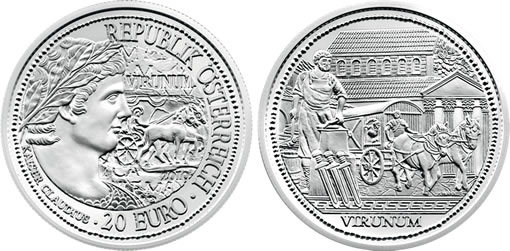For some five centuries the River Danube formed an essential part of ancient Rome’s northern border against the barbarian tribes of Germania.
The Austrian Mint’s new silver series called "Rome on the Danube" breathes life back into the ruined remains of the towns and forts that played such prominent roles in the life of the Roman Empire in Austria.
The province of Noricum covered about two-thirds of modern day Austrian territory. It had been originally a kingdom of Celtic tribes until it was taken over by the Romans in a peaceful occupation under the Emperor Augustus in about 15 B.C.
Thirty years later the Emperor Claudius converted Noricum into a regular Roman province and established the city of VIRUNUM as its administrative capital.
Military command was vested not in the governor at Virunum, but rather in the commander of the legions standing guard along the River Danube in the north. The governor was appointed by the emperor in Rome. His primary responsibility was for finance and taxation as well as for the administration of Roman law and order. His capital stood on a Roman road connecting it to Aquileia in the south and to Ovilava (Wels) in the north and the Limes or string of forts and towers guarding the Danube border.
Virunum was the cultural centre of life in Noricum with the only great amphitheatre to have been discovered on Austrian territory. Built on the classical Roman system of a rectangular grid of streets with large open forums housing temples and grand basilicas, Virunum was an unfortified township like many other such settlements — a tribute to the Pax Romana (the Roman Peace).
The streets were unpaved, but the city had a plentiful supply of water feeding public fountains and a good drainage system with lead piping. On an artificially built terrace above the city were a military camp and an elliptically shaped arena for animal and gladiatorial combat, as well as military exercises and training or parades.
The lack of walls rendered Virunum vulnerable to marauding tribes that managed to cross the Danube and raid the rich Roman province of Noricum, and in times of weakness and turmoil the city did fall prey to plundering barbarians.
In the early Christian era Virunum had its own bishop and church. Exactly when the city was abandoned we do not know, but abandoned it was. Its noble buildings of stone and marble became quarries for building materials, until the earth itself decently covered over the wounds of its ruins, leaving it to modern archaeologists to re-awaken Roman Virunum once more from its centuries’ long sleep.
Rome On The Danube Virunum Silver Coin Design
The new 20 Euro silver coin shows a profile portrait of the Emperor Claudius, who founded Virunum ("Municipium Claudium Virunum"). In the background one sees a Roman wagon drawn by a pair of horses. It is part of a grave stone from Virunum, presently affixed to the south wall of the church in neighbouring Maria-Saal.
The reverse side displays an imaginary street scene. A Roman wagon drives past the portico of a temple. At the back rise the high walls and roof of a grand basilica. In the foreground to the left we find a blacksmith hammering the highly-prized Noric iron into swords for the Roman legions. The name at the base of the coin identifies the city as Virunum.
The new € 20 silver coin is struck in proof quality only and to maximum mintage of 50,000 worldwide. Each coin comes in an attractive box with a numbered certificate of authenticity. A collection case for the whole series of six coins may be purchased separately.
In September the second coin of the series, "VINDOBONA" (Vienna), will be issued.
# # #
Coin Specifications
| Fine Weight: | 18 g AG |
| Fineness: | 900/100 g |
| Finish: | Proof |
| Diameter: | 34 mm |
| Mintage: | 50,000 |
| Date of Issue: | 5 May 2010 |
| Face Value: | 20 euro |
| Designer: | Helmut Andexlinger / H. Wähner |
About the Austrian Mint
The Austrian Mint (http://austrian-mint.at/) is situated in the heart of Vienna and is the official minting authority for Austria with a 800 year history.
The Mint is the source for all Austrian Euro and Cent coins, whether they are intended for shopping, as an investment or for collection. Before the Euro, the Schilling and Groschen coins were minted, and before that — during the monarchy — Crowns, Guilders and Ducats were struck by the Austrian Mint.
The company is located close to the center at the Vienna Stadtpark in a Biedermeier building erected under Emperor Ferdinand I. from 1835 to 1837. Today it accommodates one of the most modern mints in the world.






